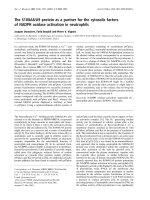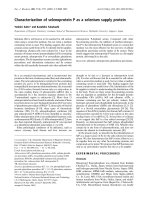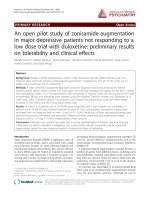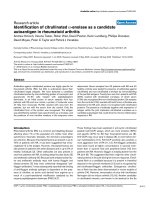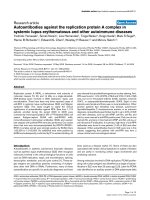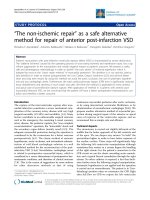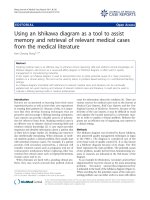Báo cáo y học: "Synthetic rabbit-human antibody conjugate as a control in immunoassays for immunoglobulin M specific to hepatitis E virus" ppsx
Bạn đang xem bản rút gọn của tài liệu. Xem và tải ngay bản đầy đủ của tài liệu tại đây (417.33 KB, 5 trang )
Zhang et al. Virology Journal 2010, 7:101
/>Open Access
RESEARCH
BioMed Central
© 2010 Zhang et al; licensee BioMed Central Ltd. This is an Open Access article distributed under the terms of the Creative Commons
Attribution License ( which permits unrestricted use, distribution, and reproduction in
any medium, provided the original work is properly cited.
Research
Synthetic rabbit-human antibody conjugate as a
control in immunoassays for immunoglobulin M
specific to hepatitis E virus
Kuo Zhang, Lunan Wang, Min Liu, Rui Zhang and Jinming Li*
Abstract
Background: In assays for anti-hepatitis E virus (HEV) immunoglobulin M (IgM), large volumes of the patient's sera
cannot be easily obtained for use as a positive control. In this study, we investigated an alternative chemical method in
which rabbit anti-HEV IgG was conjugated with human IgM and was used as a positive control in the anti-HEV IgM
assay. Rabbit anti-HEV IgG was isolated from immune sera by chromatography on protein A-Sepharose and was
conjugated with human IgM by using 1-ethyl-3-(3-dimethylaminopropyl)carbodiimide (EDC) as a crosslinker.
Results: The specific anti-HEV IgG antibody titer was 100,000 times that of the negative control, i.e., prebleed rabbit
serum. The results of anti-HEV IgM enzyme-linked immunosobent assay showed that the antibody conjugate was
similar to anti-HEV IgM antibodies produced in humans. The results of a stability experiment showed that the antibody
conjugate was stable for use in external quality assessment or internal quality control trials.
Conclusions: We concluded that the chemically conjugated rabbit-human antibody could be used instead of the
traditional serum control as a positive control in the anti-HEV IgM assay.
Background
Hepatitis E, the major form of enterically transmitted
non-A, non-B hepatitis, is caused by hepatitis E virus
(HEV) [1-3]. Although an efficient cell-culture system for
HEV has been developed and evaluated, this system can-
not be easily employed in current clinical practice
because several weeks are required to culture the virus
[4]. Viremia is thought to be present in the serum only
during the acute phase of illness, and it subsides soon
after the onset of the icteric phase as HEV antibodies
developing [5-7]. The diagnosis of HEV infection is
mainly dependent on serological examinations [7,8]. The
immunoglobulin M (IgM) antibody-capture enzyme-
linked immunosorbent assay (ELISA) was specifically
designed to detect IgM antibodies and is a valuable
marker for rapid diagnosis of acute viral infection
[6,9,10].
However, in some cases, the anti-HEV IgM assay had
relatively low sensitivity. The low sensitivity of this assay
may be attributed to the following 3 factors [8]: delayed
sampling, sequence variations among different HEV gen-
otypes, and poor host immune response to HEV infection
in some acute patients. A positive control can be included
in each run to identify the analytical problems that may
lead to false-negative results. Although a positive control
will not increase the sensitivity of the test, it will provide
information that will facilitate the identification of prob-
lems in one test and will help to improve the overall qual-
ity of HEV screening procedures.
Traditionally, a positive control is a complex of seropos-
itive plasma or serum with known quantities of anti-HEV
IgM and the negative control reagent. However, the use of
plasma or serum as positive control has several signifi-
cant drawbacks, including low stability, high cost [11,12],
difficulty in economically viable large-scale production
because the decline in the concentration of IgM antibod-
ies against HEV is steeper than that of total Ig during the
first 3 months [13-15], and potential infection with
reported 51% PCR positive when both IgG and IgM was
present in serum [16].
* Correspondence:
1
National Center for Clinical Laboratories, Beijing Hospital, Beijing, PR China
Full list of author information is available at the end of the article
Zhang et al. Virology Journal 2010, 7:101
/>Page 2 of 5
Engineered human antibodies with murine variable
regions and human constant regions have been devel-
oped as an alternative positive control; these antibodies
have overcome some drawbacks of the traditional sero-
positive control. These antibodies were successfully used
as positive controls in ELISA for Toxoplasma gondii and
scrub typhus. However, the use of hybridoma technology
and recombinant DNA technology has increased the time
required to prepare these antibodies. The affinity of engi-
neered antibodies specific for 1 epitope on a single anti-
gen is different from those of antibodies produced in
humans; which also encumbered the usage in immunoas-
says for different antigens or different epitopes on the
same antigen [11,17-19].
We investigated the feasibility of replacing the conven-
tional positive controls with an antibody conjugate in
which rabbit anti-HEV IgG was conjugated with human
IgM by using 1-ethyl-3-(3-dimethylaminopropyl) carbo-
diimide hydrochloride (EDC) as a crosslinker [20].
Methods
Immunization
We injected 2 New Zealand white rabbits with the HEV
antigen. Because anti-HEV assays based on open reading
frame 2 (ORF2) were shown to be more sensitive than
those based on ORF3 [21], we used recombinant protein
NE2 (supplied by Wantai Biotechnology Company
[China]) with an ORF2 immunodominant epitope as the
antigen. We dissolved 10 μl of the antigen (1.817 mg/ml)
in 0.9% sodium chloride. Subsequently, we emulsified 1
ml of this solution with the same volume of Freund's
complete adjuvant (Sigma, Ameriaca) and administered 1
ml of the emulsion to each rabbit; the emulsion was dis-
tributed among 8 intradermal sites on the rabbit's back.
Subsequently, 6 half-dose booster injections were admin-
istered with Freund's incomplete adjuvant (Sigma, Ame-
riaca) as above at intervals of 2 weeks, and 1 ml of blood
was withdrawn from the jugular vein each time to deter-
mine the antibody titer.
Detection of antibodies
We first performed indirect ELISA with untreated sera as
a crude test to detect the HEV antibody titer. The serum
samples were diluted to the following dilutions 1:100,
1:1,000, 1:10,000, and 1:100,000 by using a coating buffer
(50 mmol/L sodium carbonate buffer [pH9.5]). We used
100 μl of the appropriate dilution to coat the well of the
microtiter plate. After overnight incubation at 4°C, the
wells were washed 5 times using a washing buffer (10
mmol/L phosphate buffered saline (PBS) [pH9.5]). Subse-
quently, 150 μl of a blocking buffer (20% bovine serum in
PBS) was added to each well. The microtiter plates were
incubated for 2 h at 37°C and then washed 5 times using
the washing buffer. We added 100 μl of horseradish per-
oxidase (HRP)-labeled HEV-NE2 antigen (Wantai Biolog-
ical Pharmacy Enterprise Co., Ltd., Beijing) to each well,
and the plate was incubated at 37°C for 15 min. Further,
50 μl of substrate buffer (phosphate citric acid buffer [pH
9.5]) and 50 μl of tetramethylbenzidine (TMB) coloriza-
tion buffer were added to each well, and the plate was
incubated at 37°C for 15 min. Subsequently, 50 μl of stop
solution (2 mol/L H
2
SO
4
) was added to each well. Optical
density (OD) values were measured using an enzyme
immunoassay (EIA) plate reader with 2 filters of 450 nm/
620 nm.
Blood with high IgG titer was collected by carotid
artery bleeding after 3 months, and the sera were stored
at -20°C.
Antibody Purification
Rabbit IgG was isolated from immune sera by protein A-
Sepharose chromatography using HiTrap affinity col-
umns (HiTrap™; Protein A HP, Amersham Bioscience).
The elution buffer was 0.58% (v/v) acetic acid NaCl (0.15
mol/L) solution. Purification was performed according to
the manufacturer's instructions. The purified IgG was
quantified using an Eppendorf biophotometer; then,
purity was evaluated by sodium dodecyl sulfate-poly-
acryl-amide gel electrophoresis (SDS-PAGE).
Synthesis of antibody conjugate
Carboxyl and amine-reactive zero-length crosslinker
EDC was obtained from Pierce. 2-(N-morpholino) ethane
sulfonic acid (MES) was purchased from Sigma. Human
IgM was from Chemicon International, USA.
The neutralized IgG fraction and human IgM immuno-
globulin were dialyzed overnight at 4°C with stirring
against conjugation buffer (0.1 mol/L MES sodium chlo-
ride, pH 4.5). We added 1 mg each of the IgG fraction and
human IgM into 100 μl of conjugation buffer. The reac-
tion mixture was incubated at room temperature for 2 h.
Subsequently, the mixture was dialyzed overnight at
room temperature with stirring against PBS to remove
crosslinker and other by-products.
Indirect ELISA was performed with the purified rabbit
anti-HEV IgG and the antibody conjugate by using the
method described in the section on detection of antibod-
ies. OD values were measured using an EIA plate reader
with 2 filters of 450 nm/620 nm. Conjugation efficiency
was calculated by the following equation: conjugation
efficiency = (OD for the antibody conjugate/OD for the
purified rabbit anti-HEV IgG) × 100%.
To determine whether the antibody conjugate was sim-
ilar to human samples, the conjugate and positive control
serum from patients with hepatitis E were respectively
diluted in 20% newborn calf serum and PBS to dilutions
Zhang et al. Virology Journal 2010, 7:101
/>Page 3 of 5
of 1:10, 1:20, 1:40, 1:80, 1:160, 1:320, 1:640. Anti-HEV
IgM ELISA was performed using commercial kits (Beijing
Wantai Biological Pharmacy Enterprise Co. Ltd) accord-
ing to the protocols provided by the manufacturer. The
assay results for the conjugate were compared with those
for positive control serum from the patients. The anti-
body conjugate was tested in duplicate in coating buffer,
and the P/N values (P and N indicate OD values for the
positive and negative controls, the negative control used
at this instance was prebleed rabbit serum) were com-
pared with the OD values for unconjugated rabbit anti-
HEV IgG.
Stability of the antibody conjugate
We examined the stability of the antibody conjugate. Ini-
tially, the antibody conjugate was diluted 1:20 in PBS
(0.01 mol/L, pH 7.4) containing 1% bovine serum albu-
min (BSA) and 10 mM histidine. Further, we incubated
500 μl of stock solution, in duplicate, at -20°C, 4°C, 37°C,
and room temperature for 0, 1, 2, 4, and 8 weeks. Samples
were removed at each time point and the antibody titer
was measured by ELISA using an anti-HEV IgM Diagnos-
tic Kit (Wantai, Beijing).
Results
Detection of rabbit anti-HEV antibody titer
The results of ELISA (OD values) indicated that after the
sixth booster injection, the antibody titer in rabbit sera
was 100,000 times that of the negative control that was
prebleed rabbit serum (data not shown).
Purity of the rabbit IgG
The purity of IgG was evaluated by SDS-PAGE analysis.
The bands that showed the maximum staining were
observed at 50 kDa and 25 kDa, and these bands corre-
sponded to the molecular weights of heavy and light
chains of IgG, respectively. No other minor bands were
found in the sample. The sample was pure, and the effi-
ciency of sample purification was about 76.9%. The
absorbance of purified IgG was measured at 280 nm, and
the concentration of IgG was about 10 mg/ml.
Detection of the rabbit (IgG)-human (IgM) antibody
conjugate
The P/N ratio of unconjugated rabbit anti-HEV IgG (2.5)
was less than 198, which was P/N ratio of the rabbit
(IgG)-human (IgM) antibody conjugate, thereby showing
that the conjugate had been constructed. The efficiency
of conjugation was (49.75 ± 1.2)% (n = 3).
Figure 1 shows the dilution curves for the conjugate
and the serum-derived controls in anti-HEV IgM ELISA.
The endpoint titers of both the antibody conjugate and
anti-HEV IgM positive serum were 1:160, which revealed
that no significant difference was present between the
positive serum-derived control and the antibody conju-
gate.
Stability of the rabbit (IgG)-human (IgM) antibody
conjugate
The stability of the antibody conjugate was tested over a
period of 8 weeks. The results obtained at each time
point indicated that the antibody conjugate was stable for
Figure 1 Comparison between chimeric antibody and antibody-positive serum. The comparison between endpoint titers of the antibody con-
jugate and anti-hepatitis E virus (HEV) immunoglobulin M (IgM)-positive serum in anti-HEV IgM enzyme-linked immunosorbent assay (ELISA) revealed
no significant difference between the titers of positive serum-derived control and the antibody conjugate.
ε ε ε ε ε ε ε
/RJ'LOXWLRQ
2'
DQWLERG\FRQMXJDWH
S
RVLWLYHVHUXP
Zhang et al. Virology Journal 2010, 7:101
/>Page 4 of 5
at least 2 months at 37°C, 4°C, room temperature, and -
20°C. The results also showed that the antibody conjugate
was completely stable at different temperature conditions
for different periods. As shown as in Figure 2, the anti-
body conjugate could be delivered at room temperature
and stored at -20°C or at -4°C when used in external qual-
ity assessment (EQA) or internal quality control (IQC)
trials.
Discussion
In this study, we investigated a chemical method in which
rabbit anti-HEV IgG was conjugated with human IgM
and used as the positive control in immunoassays for the
detection of anti-HEV IgM. The synthetic rabbit-human
antibody conjugate offers several advantages over the tra-
ditional methods that use engineered human antibodies
or the patient's serum. First, this antibody conjugate can
be produced on a large scale and it is relatively stable.
Second, large volume with high titers of the antibody
conjugate can be easily obtained with no risk of infection
and no economic or ethical problems, and the antigen-
binding behavior of these conjugates is similar to that of
the clinical samples. Third, the antibody conjugate
derived from polyclonal antibodies has more similarity
with the human sample than engineered antibodies,
because polyclonal antibodies can recognize multiple
epitopes on HEV.
To improve the stability of the conjugate, it was diluted
in PBS (0.01 mol/L, pH 7.4) containing 1% BSA and 10
mM histidine [22]. The antibody conjugate was stable at
different temperature conditions for different periods,
and therefore, it could be used in EQA or IQC trials. Fur-
ther studies to determine the stability of this antibody
conjugate are in progress. When the antibody conjugate
is used as quality control in EQA trials, it can be delivered
by mail shipped at room temperature and kept at -20°C or
-4°C.
The rabbit-human antibody conjugate described in this
study offers an alternative method for the preparation of
a positive control that can be used in IQC and EQA trials.
We have shown for the first time a chemical conjugation
method to construct an anti-HEV IgM positive control.
This method can be also used to construct a series of pos-
itive controls that are applicable to all immunoassays,
such as ELISA, immunoblot, and immunofluorescent
assay (IFA), to detect the presence of IgM molecules spe-
cific for given antigens, for example, hepatitis A virus, T.
gondii, cytomegalovirus, herpes simplex virus, and
Rubella virus.
Conclusions
We have constructed an alternative positive control using
rabbit anti-HEV IgG conjugated with human IgM for the
detection of anti-HEV IgM. The conjugate offers several
Figure 2 Antibody conjugate stability analysis. The antibody conjugates were diluted 1:20 with phosphate buffered saline (PBS) (0.01 mol/L, pH
7.4) containing 1% bovine serum albumin (BSA) and 10 mM histidine. After incubation at 20°C, 4°C, 37°C, and room temperature for 0, 1, 2, 4, and 8
weeks, samples were removed at each time point and analyzed by enzyme-linked immunosorbent assay (ELISA) using a HEV IgM Diagnostic Kit. The
results showed that the antibody conjugate was stable enough to be used in external quality assessment and internal quality control trials.
Zhang et al. Virology Journal 2010, 7:101
/>Page 5 of 5
advantages over the traditional positive controls used in
anti-HEV IgM detection
Competing interests
The authors declare that they have no competing interests.
Authors' contributions
JL conceived the research and wrote and edited the manuscript. KZ developed
the conceptual aspects of the work, performed the experiments, and wrote
the manuscript. All authors participated in data collection and read and
approved the final manuscript.
Acknowledgements
This work was supported by funds from National Center for Clinical Laborato-
ries.
Author Details
National Center for Clinical Laboratories, Beijing Hospital, Beijing, PR China
References
1. Balayan MS, Andjaparidze AG, Savinskaya SS, Ketiladze ES, Braginsky DM,
Savinov AP, Poleschuk VF: Evidence for a virus in non-A, non-B hepatitis
transmitted via the fecal-oral route. Intervirology 1983, 20:23-31.
2. Benjelloun S, Bahbouhi B, Bouchrit N, Cherkaoui L, Hda N, Mahjour J,
Benslimane A: Seroepidemiological study of an acute hepatitis E
outbreak in Morocco. Res Virol 1997, 148:279-287.
3. Luo KX, Zhang L, Wang SS, Nie J, Yang SC, Liu DX, Liang WF, He HT, Lu Q:
An outbreak of enterically transmitted non-A, non-E viral hepatitis. J
Viral Hepat 1999, 6:59-64.
4. Tanaka T, Takahashi M, Kusano E, Okamoto H: Development and
evaluation of an efficient cell-culture system for Hepatitis E virus. J Gen
Virol 2007, 88:903-911.
5. Jameel S: Molecular biology and pathogenesis of hepatitis E virus.
Expert Rev Mol Med 1999, 1999:1-16.
6. Zhang JZ, Im SW, Lau SH, Chau TN, Lai ST, Ng SP, Peiris M, Tse C, Ng TK, Ng
MH: Occurrence of hepatitis E virus IgM, low avidity IgG serum
antibodies, and viremia in sporadic cases of non-A, -B, and -C acute
hepatitis. J Med Virol 2002, 66:40-48.
7. Herremans M, Bakker J, Duizer E, Vennema H, Koopmans MP: Use of
serological assays for diagnosis of hepatitis E virus genotype 1 and 3
infections in a setting of low endemicity. Clin Vaccine Immunol 2007,
14:562-568.
8. Lin CC, Wu JC, Chang TT, Chang WY, Yu ML, Tam AW, Wang SC, Huang YH,
Chang FY, Lee SD: Diagnostic value of immunoglobulin G (IgG) and IgM
anti-hepatitis E virus (HEV) tests based on HEV RNA in an area where
hepatitis E is not endemic. J Clin Microbiol 2000, 38:3915-3918.
9. Martin DA, Muth DA, Brown T, Johnson AJ, Karabatsos N, Roehrig JT:
Standardization of immunoglobulin M capture enzyme-linked
immunosorbent assays for routine diagnosis of arboviral infections. J
Clin Microbiol 2000, 38:1823-1826.
10. Myint KS, Guan M, Chen HY, Lu Y, Anderson D, Howard T, Noedl H,
Mammen MP Jr: Evaluation of a new rapid immunochromatographic
assay for serodiagnosis of acute hepatitis E infection. Am J Trop Med
Hyg 2005, 73:942-946.
11. Hackett J Jr, Hoff-Velk J, Golden A, Brashear J, Robinson J, Rapp M, Klass M,
Ostrow DH, Mandecki W: Recombinant mouse-human chimeric
antibodies as calibrators in immunoassays that measure antibodies to
Toxoplasma gondii. J Clin Microbiol 1998, 36:1277-1284.
12. Petersen PH, Ricós C, Stöckl D, Libeer JC, Baadenhuijsen H, Fraser C,
Thienpont L: Proposed guidelines for the internal quality control of
analytical results in the medical laboratory. Eur J Clin Chem Clin Biochem
1996, 34:983-999.
13. Koshy A, Grover S, Hyams KC, Shabrawy MA, Pacsa A, al-Nakib B, Zaidi SA,
al-Anezi AA, al-Mufti S, Burans J, Carl M, Richards AL: Short-term IgM and
IgG antibody responses to hepatitis E virus infection. Scand J Infect Dis
1996, 28:439-441.
14. Myint KS, Endy TP, Shrestha MP, Shrestha SK, Vaughn DW, Innis BL,
Gibbons RV, Kuschner RA, Seriwatana J, Scott RM: Hepatitis E antibody
kinetics in Nepalese patients. Trans R Soc Trop Med Hyg 2006,
100:938-941.
15. Favorov MO, Fields HA, Purdy MA, Yashina TL, Aleksandrov AG, Alter MJ,
Yarasheva DM, Bradley DW, Margolis HS: Serologic identification of
hepatitis E virus infections in epidemic and endemic settings. J Med
Virol 1992, 36:246-250.
16. Herremans M, Vennema H, Bakker J, Veer B van der, Duizer E, Benne CA,
Waar K, Hendrixks B, Schneeberger P, Blaauw G, Kooiman M, Koopmans
MP: Swine-like hepatitis E viruses are a cause of unexplained hepatitis
in the Netherlands. J Viral Hepat 2007, 14:140-146.
17. Jones ML, Barnard RT: Use of chimeric antibodies as positive controls in
an enzyme-linked immunosorbent assay for diagnosis of scrub typhus
(infection by Orientia tsutsugamushi). Clin Vaccine Immunol 2007,
14:1307-1310.
18. Luo W, Chen Y, Li L, Xu C, Miao J, Shih JW, Zhang J, Xia N: Construction
and characterization of the chimeric antibody 8C11 to the hepatitis E
virus. FEMS Immunol Med Microbiol 2007, 51:18-25.
19. Miyachi J, Doi K, Kitamura K, Jitsukawa T, Watanabe H: Chemically
humanized murine monoclonal antibody against a cell nuclear
antigen: usefulness in autoimmune diagnostics. J Clin Lab Anal 1992,
6:343-350.
20. Grabarek Z, Gergely J: Zero-length cross linking procedure with the use
of active esters. Anal Biochem 1990, 185:131-135.
21. Ghabrah TM, Tsarev S, Yarbough PO, Emerson SU, Strickland GT, Purcell
RH: Comparison of tests for antibody to hepatitis E virus. J Med Virol
1998, 55:134-137.
22. Monath TP: Stability of yellow fever vaccine. Dev Biol Stand 1996,
87:219-225.
doi: 10.1186/1743-422X-7-101
Cite this article as: Zhang et al., Synthetic rabbit-human antibody conjugate
as a control in immunoassays for immunoglobulin M specific to hepatitis E
virus Virology Journal 2010, 7:101
Received: 31 December 2009 Accepted: 20 May 2010
Published: 20 May 2010
This article is available from: 2010 Zhang et al; licensee BioMed Central Ltd. This is an Open Access article distributed under the terms of the Creative Commons Attribution License ( ), which permits unrestricted use, distribution, and reproduction in any medium, provided the original work is properly cited.Virology Journal 2010, 7:101
